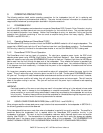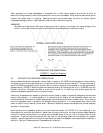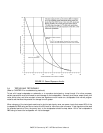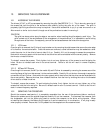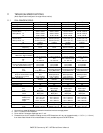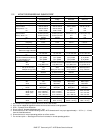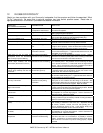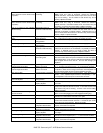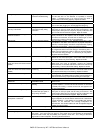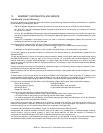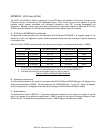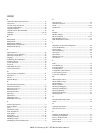
PAGE
40
Community XLT / XLTE Series Owner’s Manual
No high frequencies. High frequency driver or
crossover is malfunctioning.
Listen at low level to the high frequency driver. If some sound is heard
from this area and it is not distorted, it is probably a crossover
problem. If distorted sound or no sound is heard, the driver or
crossover may not be working properly. Replace as needed.
SYMPTOM - SUBWOOFER PROBABLE CAUSE WHAT TO DO
No bass using Neutrik connector Neutrik connector not seated Make sure Neutrik connector is fully seated by twisting it clockwise
about 1/4 turn after plugging it in. Then engage the locking ring.
Distortion, low volume, or no volume
from any or all drivers.
Cold/open solder joint on the
input panel or faulty wiring
connection.
Using an ohmmeter, check the continuity of the crimp connectors, all
solder joints on the input panel and the wiring to the drivers. Also
visually inspect solder joints as cold joints may only malfunction with
higher current than the ohmmeter supplies. Repair as needed.
No bass or bass is weak using an
electronic crossover.
No signal to the subwoofer. Check that the electronic crossover has subwoofer output, that it is
properly connected to the amplifier, that the amplifier is properly
connected to the subwoofer, and that there is sufficient gain to drive
the subwoofer in relation to the full-range loudspeakers.
Bass is weak. Incorrect subwoofer polarity. Verify the polarity is correct: + and - amplifier outputs go to + and -
on loudspeaker. Note that in some cases, due to physical loudspeaker
placement, a reversed polarity connection will provide better coupling
to the full-range loudspeaker. Check by changing the polarity.
Bass is weak. Poor physical placement. Note that in some cases, the physical placement of a subwoofer can
have a significant effect on the bass energy in the listening area. If
possible, move the subwoofer at least 10 feet from its present location
to see if the bass energy changes. If it does than you may have to
change the subwoofer location.
No bass from 51. Driver is not functioning. Disconnect the amplifier and, using an ohmmeter, measure the
resistance at one of the input jacks. If the meter reads as an open
circuit, the LF drivers may not be working. Replace as needed.
Bass is weak on model 55.
(Note: The 55 has 2 LF drivers wired in
parallel.)
One driver not functioning. Disconnect the 2 wires from the amplifier, switch the loudspeaker to
BIAMP mode, and, using an ohmmeter, measure the resistance
between the wires. If the meter reads about 6 Ohms one LF driver may
not be working. 3 Ohms is the normal reading. Replace as needed.
No bass from 55.
(Note: The 55 has 2 LF drivers wired in
parallel.)
Both drivers may not be
functioning.
Disconnect the 2 wires from the amplifier and, using an ohmmeter,
measure the resistance between the wires. If the meter reads an open
circuit, both LF drivers may not be working. Replace as needed.
No bass or bass is weak in system. Subwoofer is not functioning. Assuming all cabling and connections for the amplifiers are OK, listen
to the subwoofer at moderate levels for output from the driver(s). If
there is none the driver(s) may be malfunctioning and need repair.
FULL-RANGE OPERATED FROM SUBWOOFER FULL-RANGE OUTPUT
SYMPTOM PROBABLE CAUSE WHAT TO DO
No sound from full-range loudspeaker. High pass crossover not
working.
Disconnect subwoofer and connect full-range loudspeaker directly to
the power amplifier. If it works OK then the crossover in subwoofer
is probably not working. If it does not work OK, see symptoms for
full-range loudspeakers.
No sound from full-range loudspeaker. Cold or open solder joint on
the subwoofer input panel or
faulty wiring connection.
Using an ohmmeter, check the continuity of the crimp connectors, all
solder joints on the input panel and the wiring to the drivers. Also
visually inspect solder joints as cold joints may only malfunction with
higher current than the ohmmeter supplies. Repair as needed.
Low volume from full-range
loudspeaker or subwoofer.
Acoustic balance not optimum. When using the FULL-RANGE output on the subwoofer to feed a full-
range loudspeaker, the acoustic balance between them is determined
by their efficiencies. If this balance is not suitable then separate
amplifiers for the subwoofer and full-range loudspeaker are
recommended. The acoustic balance can then be adjusted using the
amplifier input level controls.
No sound from subwoofer. Subwoofer not working. See symptoms for subwoofers.
POLARITY CHECK FOR TWO LOUDSPEAKERS OR SUBWOOFERS
Sound image is poor and bass weak Stand in front of and exactly between the loudspeakers or subwoofers. Play a mono source through
the system. If the sound does not appear to come solidly from a point between the loudspeakers
and/or the bass is weak, they are probably out of polarity. Check the + and - wiring for the entire
signal chain to each loudspeaker. The wiring should be identical.



